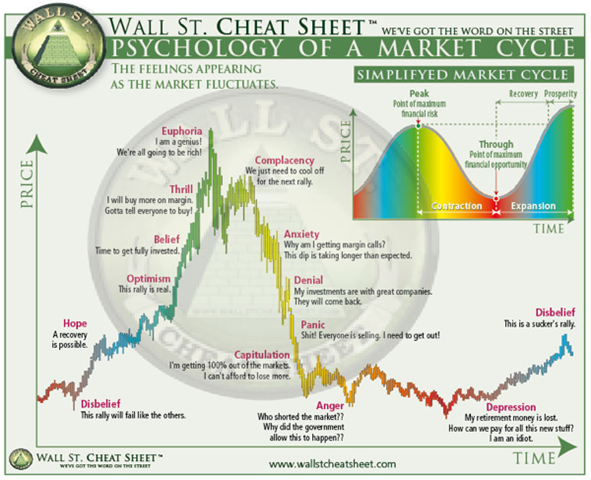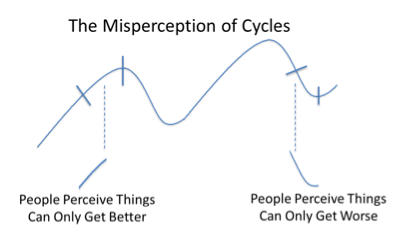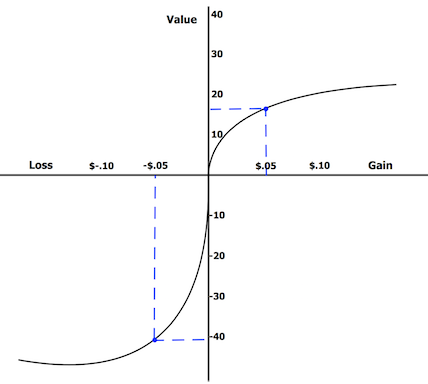Latest news about Bitcoin and all cryptocurrencies. Your daily crypto news habit.
 I bet you’ve never seen this chart before ( ͡° ͜ʖ ͡°)
I bet you’ve never seen this chart before ( ͡° ͜ʖ ͡°)
A common feeling among retail traders is that they seem to always make the wrong trade. They buy at the top, sell at the bottom, and always leave the market feeling scammed or tricked. Time after time, they make the same mistakes and become increasingly skeptical of the market’s legitimacy. This occurs because retail traders are largely unaware of the behavioral biases that govern their investing behavior. Understanding our natural tendencies and how they affect our investing behavior is an easy way to make better trades, and move against the prevailing market sentiment in order to act profitably. Drawing from theories in behavioral economics, decision theory, and psychology, I will go through some of the common biases that lead to suboptimal trading behavior.
Markets are a reflection of emotion
Generally, a market reflects the average investor sentiment at that point in time. Looking at the chart posted above, you can see that periods of high sentiment correspond to periods of bullish movement, and vice versa. The average retail investor will be in sync with the market’s overall sentiment, and therefore, will feel the most positive when the market is at its high, and least positive when the market is at its low. This naturally leads to the “buy high and sell low” phenomenon. In order to pick good entry and exit points in the market, you need to train yourself to separate market sentiment from investing opportunity. For example, if you believed that buying Ether at $1,400 was a good decision, you would logically want to buy it even more at $400, since it is fundamentally the same asset, just at a lower price. However, due to factors that I will mention later on, we are biased to not want to buy it at the lower price since the market was in a downtrend at that time.
In many ways, our brain acts as a prediction engine. In the context of investing, this means that we tend to identify patterns and trends in charts that continue existing behavior. Even worse, once we act on a prediction, we to become overly-attached to our predicted outcome, sticking to our predictions even in the face of opposing evidence. Operating in this manner leads investors to follow existing market trends, actioning upon trends that may soon reverse themselves. Acting upon existing trends is often a poor strategy because this historical behavior is likely already priced in, so little additional profit is there to be made. This is related to recency bias, which states that we value recent information much more than we do older information for decision-making purposes. The quote “Past performance is not indicative of future results” applies here, as the previous trend does not necessarily indicate anything about future movements.
Loss aversion
Another reason that people make poor trading choices is that we disproportionally value gains and losses. We naturally view not losing $X as being better than gaining $X.
However, when this principle of loss aversion is applied to trading, it clearly results in unprofitable trading behavior. Since we react more strongly to loss than we do to gain, we act illogically in order to minimize our feelings of loss, or regret, at the expense of potential gains. This means that we tend to exit profitable positions too early in order to minimize potential loss of gains, and exit losing positions too late in order to preserve our initial entry point. In order to get around this bias, it is important to set clear entry and exit points that reflect the actual amounts lost or gained, rather than our emotional states at those price points.
Zero-risk bias
Zero-risk bias states that we tend to prefer entire reduction of a small risk over a larger (but not entire) reduction of a larger risk. For example, we would rather reduce risk from 5% to 0% than reduce risk from 50% to 25%. In other words, we often prefer a guaranteed smaller benefit over a larger benefit of less certainty. This phenomenon translates over to investing in the context of balancing risk and reward. Consider the 2007–2008 recession — a period in which the markets clearly had a lot of uncertainty. Even though stock prices were at extreme lows, and buying at that point was probably a low risk (assuming you believed that the American economy would eventually recover), most people instead chose to entirely reduce risk, and bought into bonds or just used savings accounts. In this situation, we see that people chose the (nearly) zero-risk option, which had very low returns, over the slightly more risky option, which would have had far higher returns. In order to get around this bias, it is helpful to think in terms of expected value rather than purely in terms of risk, since ignoring the gains attributed to those risks results in foregoing more profitable investments.
Make sure you give this post 50 claps and follow me if you enjoyed this post and want to see more!
You can also follow me on Twitter!
Devin Soni (@devin_soni) | Twitter
Buying High and Selling Low was originally published in Hacker Noon on Medium, where people are continuing the conversation by highlighting and responding to this story.
Disclaimer
The views and opinions expressed in this article are solely those of the authors and do not reflect the views of Bitcoin Insider. Every investment and trading move involves risk - this is especially true for cryptocurrencies given their volatility. We strongly advise our readers to conduct their own research when making a decision.

